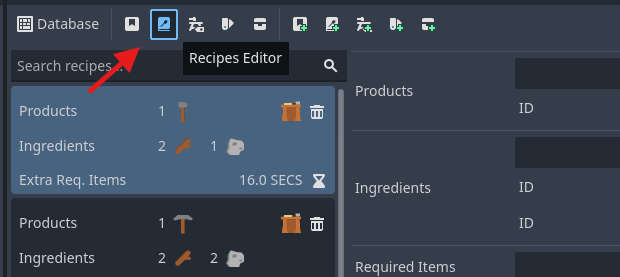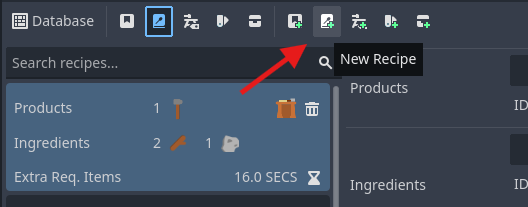Recipes
Recipes define what items can be created through crafting and what materials are required. In the inventory system, recipes are resources that contain all the information needed for crafting items at CraftStation nodes.
Recipes Overview
A recipe consists of several components:
Ingredients: Items that are consumed during crafting
Required Items: Items needed for crafting but not consumed (like tools)
Products: Items produced when crafting is completed
Station Type: The specific CraftStationType required for this recipe
Craft Time: How long the crafting process takes
Creating Recipes
Recipes are created and managed through the InventoryDatabase editor. Here’s how to create a new recipe:
Open the Database Editor
Open your inventory database resource in the Inspector. The database editor will appear at the bottom of the editor.
Navigate to Recipes
In the database editor, locate the “Recipes” section.

Add New Recipe
Click the “+” button to create a new recipe. A new recipe entry will appear in the list.

Configure Recipe Properties
Set the following properties for your recipe:
Station: Select the CraftStationType required for this recipe (optional)
Time to Craft: Set the duration for crafting in seconds
Ingredients: Add the items that will be consumed during crafting
Required Items: Add items needed but not consumed (like tools)
Products: Add the items that will be produced

Recipe Properties
Ingredients
Ingredients are items that get consumed during the crafting process. These items are removed from the input inventories of the craft station.
When ingredients are removed:
If only_remove_ingredients_after_craft is
false: Ingredients are removed when crafting startsIf only_remove_ingredients_after_craft is
true: Ingredients are removed when crafting completes
Note
Each ingredient is an ItemStack that specifies both the item and the quantity needed.
Required Items
Required items are items that must be present in the input inventories for crafting to begin, but they are not consumed during the process. This is useful for tools or permanent equipment.
Example use cases:
Crafting tools (hammer, anvil, etc.)
Fuel sources that aren’t consumed per recipe
Permanent equipment or machinery
Products
Products are the items created when crafting is successfully completed. These items are added to the output inventories of the craft station.
Note
Products are added to output inventories only when crafting completes successfully.
Station Type
The station type determines which CraftStation nodes can execute this recipe. Only craft stations with a matching type will include this recipe in their valid_recipes list.
Note
If no station type is set, the recipe will be available to craft stations that also have no type set.
Craft Time
The time (in seconds) required to complete the crafting process. During this time, the recipe will be in the craft station’s craftings list.
Recipe Validation
Before a recipe can be crafted, the system validates:
Station Compatibility: The craft station must have the same type as the recipe (or both must have no type)
Ingredient Availability: All required ingredients must be available in input inventories
Required Item Availability: All required items must be present in input inventories
Output Space: There must be space in output inventories for the products
Tip
Use the can_craft() method to check if a recipe can be executed before starting the crafting process.
Best Practices
Recipe Organization
Group related recipes by station type
Use descriptive names for easy identification
Consider crafting time balance for gameplay
Station Type Assignment
Assign specific station types to organize crafting (e.g., “Furnace”, “Workbench”, “Alchemy Table”)
Leave station type empty for universal recipes that can be crafted anywhere
Use consistent naming conventions for station types
Balancing
Consider ingredient rarity and availability
Balance crafting time with recipe complexity
Ensure product value matches ingredient cost
See also
CraftStationType - Learn about CraftStationType resources
Craft Stations - Learn about using CraftStation nodes